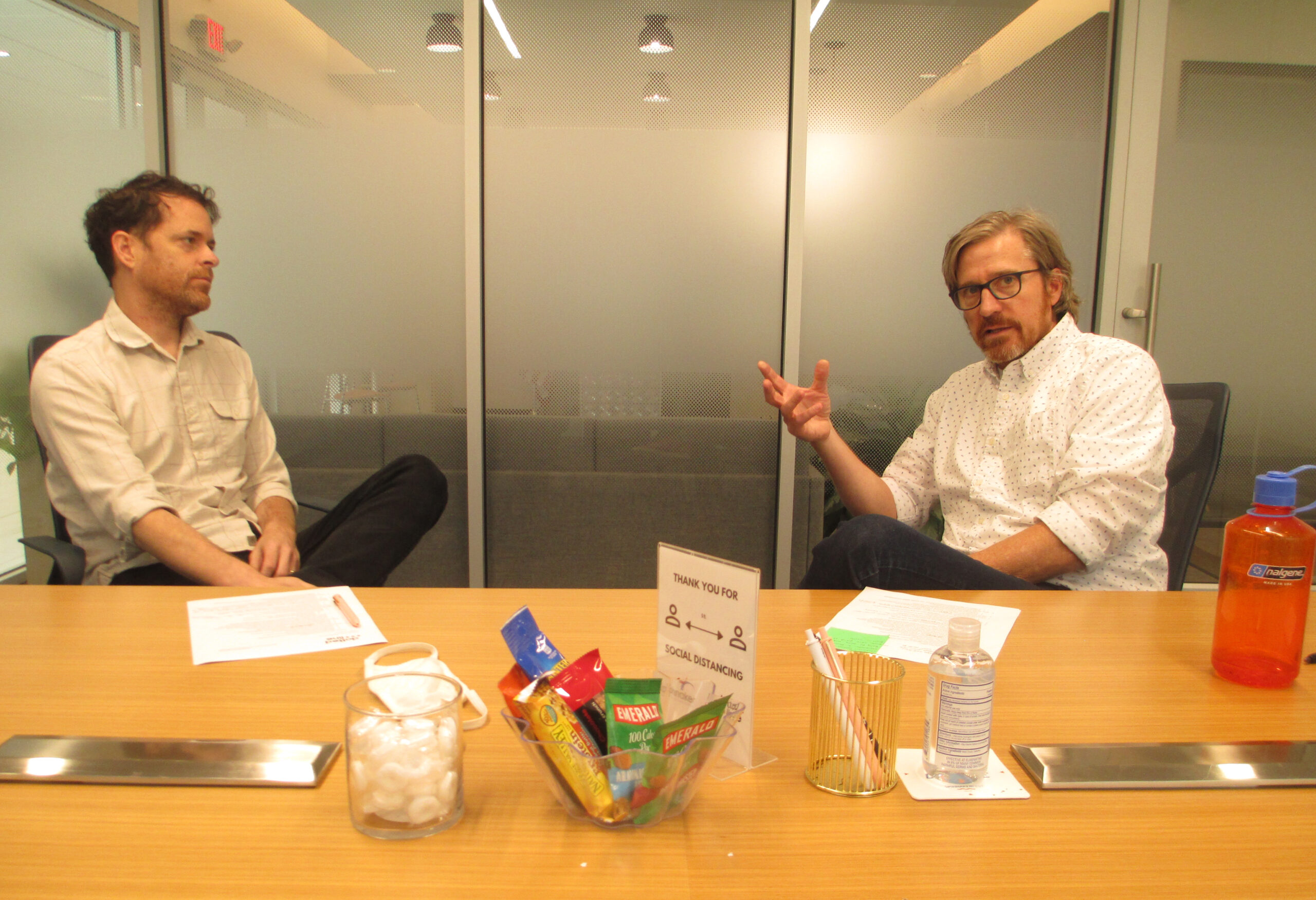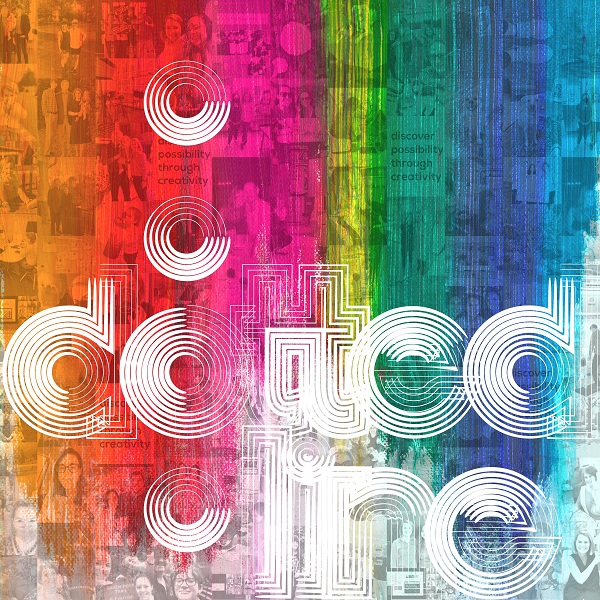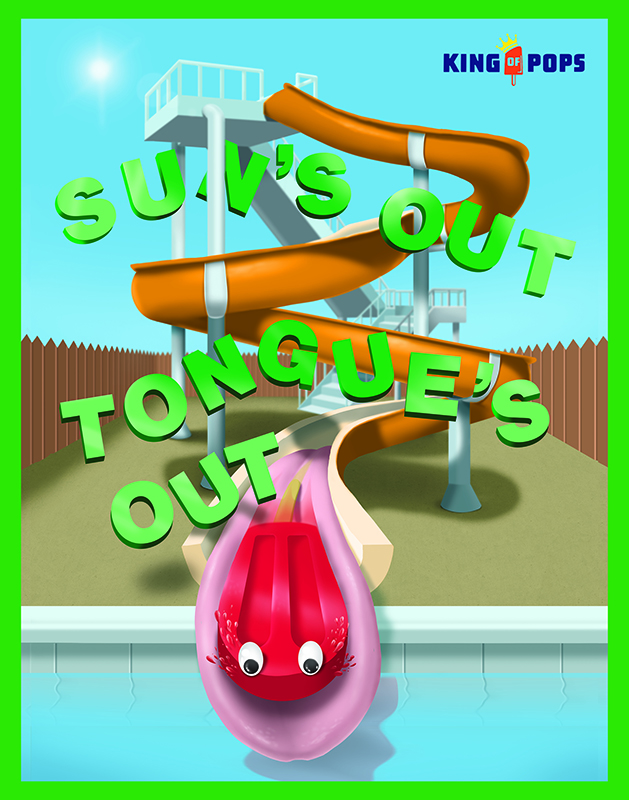
Mitchell Jordan, left, and Jason Anderson at Dotted Line’s office in Forest Office Park. They joined the agency this year after working together previously at NDP. (Jonathan Spiers photos)
When former NDP staffers Jason Anderson and Mitchell Jordan signed on with marketing firm Dotted Line earlier this year, they were, as Jordan put it, getting the band back together in more ways than one.
Before they were caught up in a round of layoffs that sent them packing from NDP in 2019, Anderson, a creative director at the agency for 10 years, and Jordan, a designer there for four, had not only worked together on projects but also pursued their musical interests with after-hours jam sessions in the agency’s basement.
Their shared musical tastes and other creative influences kept them connected as Anderson worked freelance gigs and Jordan took a staff job with Franklin Street Marketing.
Anderson’s freelancing included work for Dotted Line and, when the agency brought him on full-time in January, he recommended Jordan to help build a department and bring the firm’s creative work in-house.
Since then, the duo’s work has included introducing Dotted Line to the still-emerging world of NFTs. They created one of the so-called non-fungible tokens for the agency as a way of exploring the blockchain technology’s potential, while also providing a team-building exercise as they also work to build their new department.
Anderson and Jordan sat down with BizSense to discuss that task, their reunion at Dotted Line and just what an NFT is. The following is an edited transcript:
Richmond BizSense: How was it that you came to work together again at Dotted Line after your days at NDP?
Jason Anderson: Dotted Line traditionally had been (more account-focused), with creative being strictly freelance. As Lauren Sweeney, the founder, grew her team, she saw that the agency was at a point where if we really wanted to offer clients the full package and be able to scale up for bigger engagements, that bringing on creative and building it in-house, it was the time to do it.
We didn’t necessarily come as a package, but I had been doing some projects with Dotted Line and the opportunity came that we needed a strong, high-level art director-designer to help build the creative team, and Mitchell was definitely the first person I thought of. He came in and met with Lauren and the team and we did a project or two together. It was a good fit, and I think our history together was a big part of that.
RBS: What’s your approach to taking on a new account or piece of creative?
Mitchell Jordan: From an inspiration standpoint, I think we look toward the same movies and music and TV and weird YouTube videos, whatever’s going to get a conversation going.

Jordan and Anderson led Dotted Line in creating an agency-specific NFT. “It’s that mystery of how does it translate – does it translate – to a true marketing plan?” Anderson said.
RBS: Explain this NFT you made. Why did you make it?
MJ: We were working as a team on social media content and talking about doing a blurb on the world of NFTs. This artist, Beeple, sold an NFT at auction for $69 million, and people were like, “What is this?” Ultimately it was a way of authenticating a piece of digital artwork. While you might have several copies of something that exists on Facebook, there can really only be one version of whatever you’re selling as an NFT.
We started talking about, how could we use it in a general way, how is it applicable to our clients or our personal lives. We started throwing around this idea of what if we just made our own to understand the process. It felt relevant, and it felt kind of cool to have a piece of digital artwork that’s applicable to Dotted Line that has this sort of timestamp on it.
We did a cattle call, like, “Hey, if you don’t mind having your image appear as it is for all of eternity, would you send us some pictures for us to use?” We created a collage of imagery overlaid by a conceptual Dotted Line logo and these swashes of rainbow colors meant to represent all the walks of life that people that work for Dotted Line come from. Not super high-concept, but really a lot of fun.

An image of Dotted Line’s NFT, compiled from images submitted by agency employees. (Images courtesy of Dotted Line)
RBS: What did you take away from the experience, as far as how it could be used in advertising and marketing?
JA: That’s the big question. It’s kind of like when Twitter launched: “How are you going to monetize this?” It’s that mystery of how does it translate – does it translate – to a true marketing plan?
Maybe that’s not clear right now, but as it evolves, it’s one of those things where it’s good to have a glimpse into what they are now so we can continue to see how they’ll move and shape, so that if it’s at any point relevant and anything that our client needs to help us achieve their goals – whether it be growth, awareness, engagement – we want to be able to say we are experts.
MJ: We think we’re ahead of the curve with it already. It could be that we are briefed on something from a strategy perspective and then we think, “What would be awesome is if we did this NFT, and this is how it applies to answering this brief and how it applies to the client.” I don’t know that it’s obvious how it applies, but I think that there will be a creative use for it for brands in the not-too-distant future.
RBS: What other ad work have you done that people might recognize?
MJ: (Ice pop maker) King of Pops was something that we specifically worked on together. We worked with an illustrator in the design studio to come up with a poster series of these popsicles hanging out at a pool, everything was personified.
JA: It was the line: “Sun’s out, tongue’s out.” I remember sticking the line up on the wall, and it was one of those moments where I was like, “I think that’s it!”
MJ: And that drove the visual of it too. They were sort of like Pixar-meets-Salvador Dali.
RBS: Are there other shops in town whose work you admire?
MJ: One of the agencies that stands out to me is Familiar Creatures. They’re doing really great work, especially from a design perspective. There’s also 903 that does some really nice work as well.
JA: Familiar Creatures does great work. Arts & Letters, it’s been amazing watching them just explode size-wise and doing great work for such a powerful client (Google). Hearing their growth is really exciting and only does great things for a city the size of Richmond, and having those big players continues to help fuel and grow the advertising and creative community. It’s a great town to work in.
RBS: If you could get advice from one person in or outside the industry, living or deceased, who would that person be and what question would you ask?
MJ: There was an industrial designer who worked for Braun, Dieter Rams. He was very much a less-is-more kind of designer. He would take those things that you might think are kind of mundane, make them beautiful but also make them incredibly functional. I’d like to ask him how he rides that line of maintaining his design integrity and also creating something that’s commercially viable, because I think it’s very tricky and he did that very well.
JA: I would love to ask Nicola Tesla what he thinks of Elon Musk, because of the lens of Tesla being a futurist scientist. His was science, dreamer, futurist, and Musk, I’d call him a futurist, but his is from a business standpoint. He hires scientists to make this Hyperloop, where Tesla would actually be in the lab. I’d love a “Bill and Ted’s Excellent Adventure”-type, bring him in and be like, “What do you think of him using your name?”

Mitchell Jordan, left, and Jason Anderson at Dotted Line’s office in Forest Office Park. They joined the agency this year after working together previously at NDP. (Jonathan Spiers photos)
When former NDP staffers Jason Anderson and Mitchell Jordan signed on with marketing firm Dotted Line earlier this year, they were, as Jordan put it, getting the band back together in more ways than one.
Before they were caught up in a round of layoffs that sent them packing from NDP in 2019, Anderson, a creative director at the agency for 10 years, and Jordan, a designer there for four, had not only worked together on projects but also pursued their musical interests with after-hours jam sessions in the agency’s basement.
Their shared musical tastes and other creative influences kept them connected as Anderson worked freelance gigs and Jordan took a staff job with Franklin Street Marketing.
Anderson’s freelancing included work for Dotted Line and, when the agency brought him on full-time in January, he recommended Jordan to help build a department and bring the firm’s creative work in-house.
Since then, the duo’s work has included introducing Dotted Line to the still-emerging world of NFTs. They created one of the so-called non-fungible tokens for the agency as a way of exploring the blockchain technology’s potential, while also providing a team-building exercise as they also work to build their new department.
Anderson and Jordan sat down with BizSense to discuss that task, their reunion at Dotted Line and just what an NFT is. The following is an edited transcript:
Richmond BizSense: How was it that you came to work together again at Dotted Line after your days at NDP?
Jason Anderson: Dotted Line traditionally had been (more account-focused), with creative being strictly freelance. As Lauren Sweeney, the founder, grew her team, she saw that the agency was at a point where if we really wanted to offer clients the full package and be able to scale up for bigger engagements, that bringing on creative and building it in-house, it was the time to do it.
We didn’t necessarily come as a package, but I had been doing some projects with Dotted Line and the opportunity came that we needed a strong, high-level art director-designer to help build the creative team, and Mitchell was definitely the first person I thought of. He came in and met with Lauren and the team and we did a project or two together. It was a good fit, and I think our history together was a big part of that.
RBS: What’s your approach to taking on a new account or piece of creative?
Mitchell Jordan: From an inspiration standpoint, I think we look toward the same movies and music and TV and weird YouTube videos, whatever’s going to get a conversation going.

Jordan and Anderson led Dotted Line in creating an agency-specific NFT. “It’s that mystery of how does it translate – does it translate – to a true marketing plan?” Anderson said.
RBS: Explain this NFT you made. Why did you make it?
MJ: We were working as a team on social media content and talking about doing a blurb on the world of NFTs. This artist, Beeple, sold an NFT at auction for $69 million, and people were like, “What is this?” Ultimately it was a way of authenticating a piece of digital artwork. While you might have several copies of something that exists on Facebook, there can really only be one version of whatever you’re selling as an NFT.
We started talking about, how could we use it in a general way, how is it applicable to our clients or our personal lives. We started throwing around this idea of what if we just made our own to understand the process. It felt relevant, and it felt kind of cool to have a piece of digital artwork that’s applicable to Dotted Line that has this sort of timestamp on it.
We did a cattle call, like, “Hey, if you don’t mind having your image appear as it is for all of eternity, would you send us some pictures for us to use?” We created a collage of imagery overlaid by a conceptual Dotted Line logo and these swashes of rainbow colors meant to represent all the walks of life that people that work for Dotted Line come from. Not super high-concept, but really a lot of fun.

An image of Dotted Line’s NFT, compiled from images submitted by agency employees. (Images courtesy of Dotted Line)
RBS: What did you take away from the experience, as far as how it could be used in advertising and marketing?
JA: That’s the big question. It’s kind of like when Twitter launched: “How are you going to monetize this?” It’s that mystery of how does it translate – does it translate – to a true marketing plan?
Maybe that’s not clear right now, but as it evolves, it’s one of those things where it’s good to have a glimpse into what they are now so we can continue to see how they’ll move and shape, so that if it’s at any point relevant and anything that our client needs to help us achieve their goals – whether it be growth, awareness, engagement – we want to be able to say we are experts.
MJ: We think we’re ahead of the curve with it already. It could be that we are briefed on something from a strategy perspective and then we think, “What would be awesome is if we did this NFT, and this is how it applies to answering this brief and how it applies to the client.” I don’t know that it’s obvious how it applies, but I think that there will be a creative use for it for brands in the not-too-distant future.
RBS: What other ad work have you done that people might recognize?
MJ: (Ice pop maker) King of Pops was something that we specifically worked on together. We worked with an illustrator in the design studio to come up with a poster series of these popsicles hanging out at a pool, everything was personified.
JA: It was the line: “Sun’s out, tongue’s out.” I remember sticking the line up on the wall, and it was one of those moments where I was like, “I think that’s it!”
MJ: And that drove the visual of it too. They were sort of like Pixar-meets-Salvador Dali.
RBS: Are there other shops in town whose work you admire?
MJ: One of the agencies that stands out to me is Familiar Creatures. They’re doing really great work, especially from a design perspective. There’s also 903 that does some really nice work as well.
JA: Familiar Creatures does great work. Arts & Letters, it’s been amazing watching them just explode size-wise and doing great work for such a powerful client (Google). Hearing their growth is really exciting and only does great things for a city the size of Richmond, and having those big players continues to help fuel and grow the advertising and creative community. It’s a great town to work in.
RBS: If you could get advice from one person in or outside the industry, living or deceased, who would that person be and what question would you ask?
MJ: There was an industrial designer who worked for Braun, Dieter Rams. He was very much a less-is-more kind of designer. He would take those things that you might think are kind of mundane, make them beautiful but also make them incredibly functional. I’d like to ask him how he rides that line of maintaining his design integrity and also creating something that’s commercially viable, because I think it’s very tricky and he did that very well.
JA: I would love to ask Nicola Tesla what he thinks of Elon Musk, because of the lens of Tesla being a futurist scientist. His was science, dreamer, futurist, and Musk, I’d call him a futurist, but his is from a business standpoint. He hires scientists to make this Hyperloop, where Tesla would actually be in the lab. I’d love a “Bill and Ted’s Excellent Adventure”-type, bring him in and be like, “What do you think of him using your name?”




Couldn’t agree more. But these days, we seem to place value on the strangest things.
Another indication that modern society is in big trouble